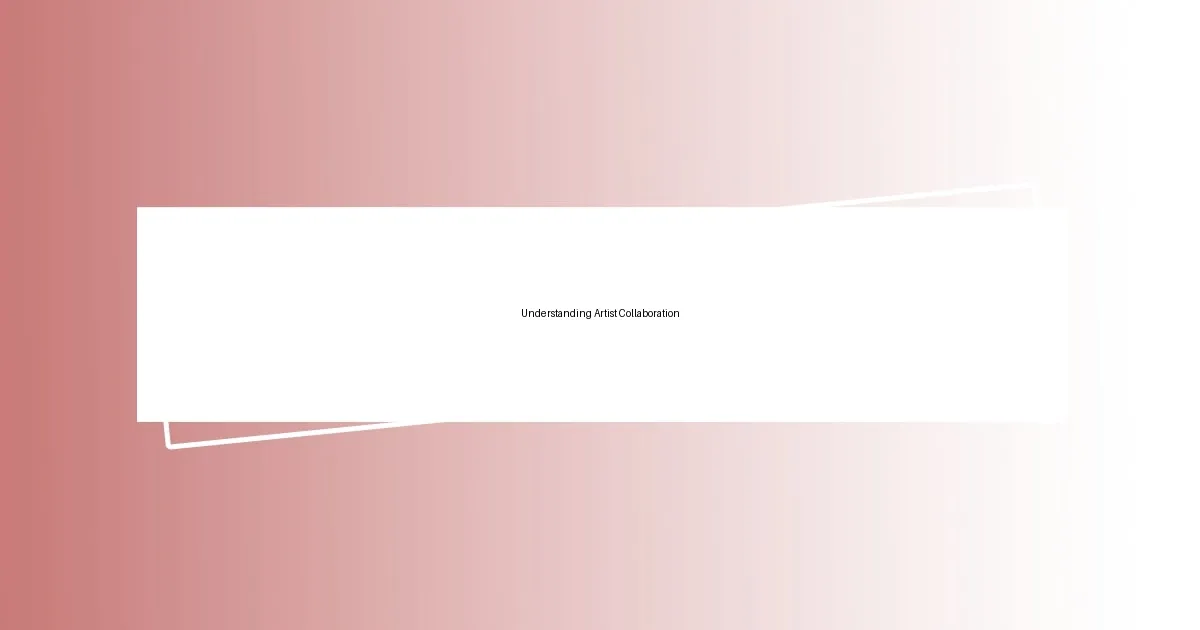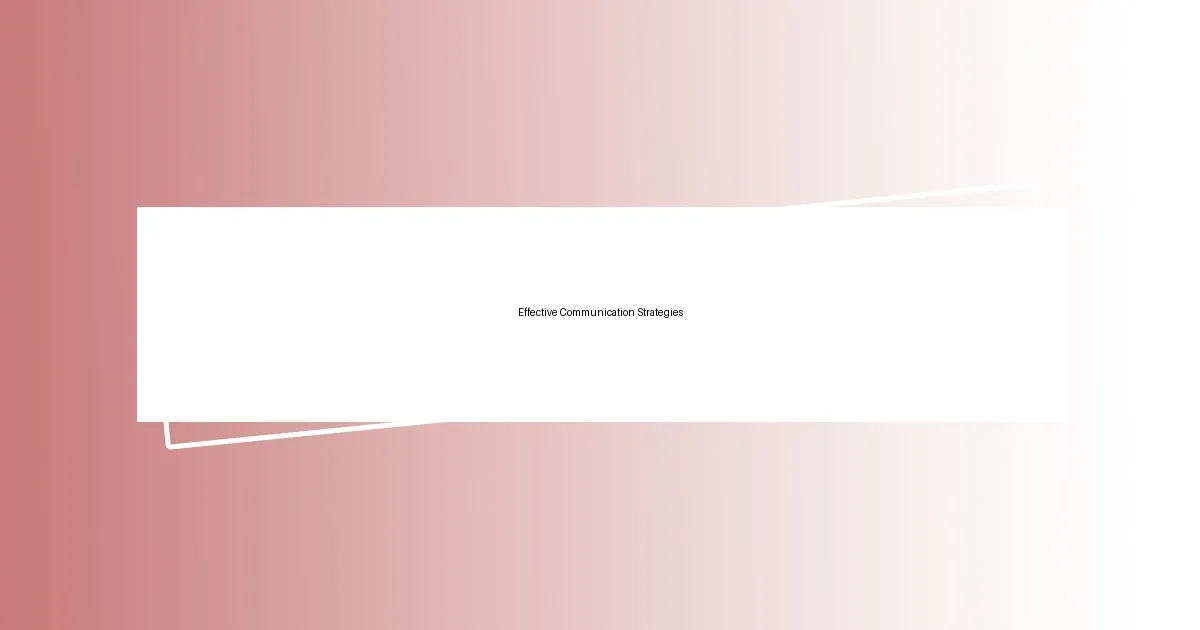Key takeaways:
- Collaboration enhances creativity by merging different art styles and fostering innovation through emotional connections.
- Building trust with artists requires authentic interactions, vulnerability, and transparency to create a supportive environment.
- Effective communication, including active listening and open-ended questions, is crucial for successful artistic partnerships.
- Nurturing long-term relationships involves consistent engagement, adaptability, and celebrating collective achievements to strengthen bonds.

Understanding Artist Collaboration
When I think about artist collaboration, I can’t help but recall a time when I teamed up with a painter to create a mixed media installation. The process was thrilling! It challenged us to blend our distinct styles while respecting each other’s visions. Have you ever found yourself harmonizing with someone whose art style is starkly different from yours? That’s the beauty of collaboration—it pushes boundaries and inspires innovation.
Understanding artist collaboration also means recognizing the emotional nuances involved. I remember discussing ideas over coffee with a sculptor friend; our conversation flowed like the creative energy in the room. We both shared fears of artistic rejection and hopes for meaningful expression. Isn’t it fascinating how those emotions can link artists together, fueling their creativity?
Moreover, effective collaboration hinges on clear communication and trust. I’ve experienced misunderstandings that arose from assumptions. When I approached a writer about integrating text into our visual project, we had to navigate those waters delicately. Have you ever faced similar challenges? It’s moments like these that highlight the importance of openness and a willingness to adapt in collaborative efforts.

Building Trust with Artists
Building trust with artists is crucial for any effective collaboration. Trust doesn’t just happen overnight; it’s cultivated through consistent, authentic interactions. I remember once attending an art show where I met a photographer whose work truly moved me. Instead of just praising their pieces, I initiated a genuine conversation about their creative process and inspirations. This openness created an immediate connection, reinforcing the bond of trust between us.
Creating a safe space for artists to express their vulnerabilities is another essential aspect of building trust. I once collaborated on a project where we shared our personal stories behind our art, revealing fears and aspirations. This experience not only deepened our connection but also unlocked a new level of creativity. Have you ever shared a personal story and felt the walls around you dissolve? That’s the magic of trust in artistic relationships.
Finally, transparency plays a vital role. I learned this the hard way during a project where I hesitated to voice my concerns about the artistic direction. The moment I openly shared my thoughts, the collaboration shifted to a more comfortable space where everyone felt valued. It reminded me that trust thrives on honesty—when you express yourself genuinely, it encourages others to do the same.
| Aspects of Trust | My Experience |
|---|---|
| Authentic Interactions | Connecting with a photographer at an art show. |
| Vulnerability | Sharing personal stories during a project. |
| Transparency | Openly voicing concerns about artistic direction. |

Effective Communication Strategies
Effective communication is the bedrock of any successful relationship with artists. One strategy I’ve found invaluable is active listening. When I sat down with a muralist, I made a point to listen intently, asking questions that showed I valued her perspective. This simple act not only made her feel heard but also allowed me to grasp the intricacies of her vision. What I’ve learned is that communication isn’t just about talking; it’s about making space for others to express themselves.
Here are some communication strategies I’ve applied:
- Ask Open-Ended Questions: I’ve discovered that questions like “What inspires your work?” open up deeper conversations and insights.
- Use Simple Language: In discussions about technical details, I aim to minimize jargon. Clarity is key!
- Non-Verbal Cues: I pay attention to body language and facial expressions, which often communicate feelings that words may not capture.
- Follow Up: After a brainstorming session, sending a quick message summarizing our ideas shows my commitment to their thoughts and enhances collaboration.
By recognizing these elements, I foster a richer dialogue that fuels creativity and builds rapport.

Showcasing Mutual Benefits
Highlighting the mutual benefits of collaboration is essential when building relationships with artists. During a collaborative project with a painter, we both discovered that our different skill sets complemented each other beautifully. As I shared my marketing expertise, she opened up her artistic techniques, and together we crafted a campaign that elevated her visibility. have you ever participated in a project where your strengths truly amplified the other’s work? There’s nothing quite like that shared success.
Moreover, showcasing how our partnerships provide shared exposure can be a game-changer. I once teamed up with an illustrator for a local gallery event, and we not only showcased our individual talents but also merged them into a unique installation. The synergy attracted a larger audience, benefiting both of our profiles significantly. I felt that thrill of connecting with new fans, and I relished in seeing my collaborator enjoy the same recognition. That exchange solidifies the idea that together, we can achieve so much more.
It’s also important to highlight how fostering a supportive environment directly enhances the quality of our work. I remember a moment during a brainstorming session where I encouraged a musician to explore a different sound, and that sparked a creative breakthrough for her. Seeing her eyes light up, filled with inspiration, was a powerful reminder of how our collective efforts enrich artistic expression. Isn’t it fascinating how often our ideas can ignite another’s creativity? The benefits flow both ways, creating a cycle of growth and innovation that’s truly rewarding.

Creating Authentic Connections
Creating authentic connections with artists goes beyond mere surface-level interactions. I remember a time when I was setting up an exhibition with a sculptor. Instead of diving straight into the logistics, I took a moment to discuss her artistic journey and the stories behind her pieces. That simple act of sharing created a bond that made our collaboration so much richer. It’s as if we were no longer just two professionals working on a project; we became co-creators sharing a deeper vision.
Additionally, I’ve found that vulnerability plays a crucial role in fostering these connections. There was an occasion when I hesitated to share my doubts about my own artistic contributions, fearing it might undermine my credibility. To my surprise, when I finally opened up, not only did the artist respond with empathy, but it encouraged her to share her own insecurities. That moment of honesty transformed our dynamics, paving the way for a partnership built on trust and understanding. Have you ever experienced that transformative power of vulnerability in a professional relationship?
Lastly, I cherish the idea of celebrating small wins together. During a recent project launch, I proposed a toast to our collective achievements, no matter how minor. Watching the joy in my collaborator’s eyes as we acknowledged the journey we had taken together was heartwarming. It reinforced the notion that every step holds significance in our creative paths. Isn’t it amazing how these shared moments not only strengthen our bond but also enhance the creative process?

Nurturing Long Term Relationships
Building lasting relationships with artists requires consistent effort and genuine engagement. I remember collaborating with a graphic designer over several projects. Each time we worked together, we took the time to check in on each other’s lives—our personal struggles and triumphs. This open exchange fostered a deeper understanding between us and allowed us to create richer work. Have you ever shared your life experiences with a collaborator? It can truly enhance the creative synergy.
It’s essential to remain present and supportive throughout the creative journey, not just during the initial collaboration phase. During a year-long partnership with a photographer, I made a point to attend her exhibitions and local shows. Not only did this demonstrate my ongoing support, but it also showed her that her work was meaningful to me. That created a sense of loyalty and mutual respect, and she often reached out for feedback and ideas because she knew I was genuinely invested in her success. How often do we pause to show our collaborators that we truly care?
Lastly, I find that nurturing these relationships involves being adaptable and understanding. Once, I had to adjust my marketing plan significantly due to an artist’s evolving vision. Instead of pushing my agenda, I embraced the changes, and in doing so, I discovered new angles to promote her work. It made me appreciate her perspective deeply, and as a result, our partnership blossomed. Have you been in a situation where adaptability led to unexpected growth? It’s moments like these that crystallize why nurturing long-term relationships in the arts is so rewarding.

Evaluating Success of Collaborations
Evaluating the success of collaborations can sometimes be elusive, but I’ve discovered that having clear metrics is incredibly helpful. For instance, I once partnered with a muralist, and we set specific goals like audience engagement and feedback during the unveiling. It was enlightening to see just how measurable our success became when we focused on tangible outcomes, diving deep into the audience’s reactions and conversations around the piece. Have you thought about what success looks like for you in a creative partnership?
Reflecting on the qualitative aspects of collaboration is equally crucial. After working on an audio-visual project with a musician, I found that the joy and excitement expressed in our post-collaboration chat spoke volumes. It wasn’t just the project outcome that mattered; it was the connection we built and the creativity we sparked together. That emotional resonance often indicated our collaboration’s success more than any number can. Isn’t it fascinating how feelings often measure success just as much as metrics?
Finally, soliciting feedback can be a game-changer. I remember asking a visual artist for her thoughts on our recent project during our wrap-up meeting, and she shared that it was one of the most enjoyable experiences she’d ever had. When collaboration feels fulfilling, it often leads to future opportunities and a network of support. Have you ever gathered feedback to not only evaluate success but also to strengthen your partnerships moving forward? It’s one of those simple practices that always yields positive results in my experience.














